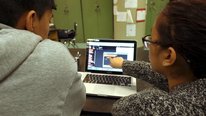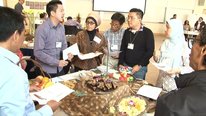NATALIA VILLANUEVA ROSALES
Cyber-ShARE; CAHSI
This video will showcase the work being done at the NSF CREST-funded CyberShARE Center of Excellence leveraging the best practices from the NSF BPC-funded Computing Alliance of Hispanic-Serving Institutions. Our work at the Center has focused on preparing a new generation of creative STEM thinkers through projects that cross disciplines and require the ability of the students to work not only on interdisciplinary teams, but with students from different cultures and backgrounds. An exemplar is our participation in the Smart Cities Initiative that aims to be a model for interdisciplinary, international collaboration to advance the knowledge needed to transform cities into smart cities through joint research and education. The video highlights students and faculty from UTEP and the Universidad de Guadalajara using models for knowledge exchange and team building. These models have been developed by student scholars and faculty at the Center and CAHSI. Students learn how to use computing techniques and cyberinfrastructure to address challenges posed by cities across borders.
Cyber-ShARE; CAHSI
This video will showcase the work being done at the NSF CREST-funded CyberShARE Center of Excellence leveraging the best practices from the NSF BPC-funded Computing Alliance of Hispanic-Serving Institutions. Our work at the Center has focused on preparing a new generation of creative STEM thinkers through projects that cross disciplines and require the ability of the students to work not only on interdisciplinary teams, but with students from different cultures and backgrounds. An exemplar is our participation in the Smart Cities Initiative that aims to be a model for interdisciplinary, international collaboration to advance the knowledge needed to transform cities into smart cities through joint research and education. The video highlights students and faculty from UTEP and the Universidad de Guadalajara using models for knowledge exchange and team building. These models have been developed by student scholars and faculty at the Center and CAHSI. Students learn how to use computing techniques and cyberinfrastructure to address challenges posed by cities across borders.
5769 Views
Continue the discussion of this presentation on the Multiplex. Go to Multiplex







Lisa Samford
Executive Director
Hi Natalia—What an interesting and relevant project. How much time did the students from the two schools spend together? Was this supplemented by virtual engagement? How long did the project continue?
Natalia Villanueva Rosales
Assistant Professor
Thank you, Lisa. This project is still on-progress as we speak. They spent one week together here at El Paso, they are continuing working having virtual meetings and they are schedule to spend two more weeks together in Guadalajara. In total, they will spend about two months working on their projects.
Vivian Guilfoy
Senior Advisor
Exchanging ideas and solving problems through Smart Cities is a great way to enhance learning across borders. Can you give us a few examples of the specific projects students are tackling? What role does faculty play in the process? How are city leaders involved in the work? What kinds of research and collaboration seem to generate the most engagement? What would you say are the most significant outcomes from the collaborations so far? Biggest challenges?
Natalia Villanueva Rosales
Assistant Professor
These are all great questions, Vivian. Thank you.
Students are working on specific projects in the areas of Smart Mobility, Smart Buildings and Smart Health Care. Their initial ideas include using technology (apps) to improve mobility of disabled people by coordinating volunteer carpooling, and detecting and fixing water leaks in buildings.
Faculty worked together for about 4-5 months in identifying challenges in both cities, Guadalajara and El Paso, engaging city decision-makers in the process.
The Faculty team created a customized set of lectures and workshops for the students so they can learn the skills needed to tackle the challenges identified in advance.
The hardest and more challenging part is to create interdisciplinary, international team of students. Students have been amazingly productive at contributing their perspectives and respecting teammate’s perspectives. The generation of diverse and new ideas has been incredible.
We have also engaged industry and students will present their projects at a hackathon, which is a two-day event where people gather to generate software programs for a specific application. The Smart Cities hackathon is led by our industry partner IBM and will coincide with the gathering of our students in Guadalajara.
Vivian Guilfoy
Senior Advisor
Very exciting process and I hope you will be documenting the projects at the hackathon. It would be wonderful to hear firsthand from the students about how this effort impacts their attitudes and skills, what they see as common issues across countries, and future career paths. How will you disseminate and share the findings?
Jorge Solis
Thank you Natalia for sharing this great collaboration between UTEP and UDG. I was wondering how K-12 schools relate to the Smart Cities work so far?
Brian Drayton
Exciting!
Does your “inter discipline” reach outside engineering to include, for example, public health students, media students, ecologists, or others who might contribute useful expertise in design and education about their ideas?
Tamara Ball
Asst. Project Scientist
It is always great to see collaborative project-based learning in action. Can you tell us more about what specific STEM or CS skills students in this program are learning? Did the faculty know in advance what skills would be needed or was this determined after the project scope was defined by individual student teams? In my own experience I have found it challenging to lead interdisciplinary teams when one student is very familiar with a software or tool (e.g. EXCEL) and others are not. How do you manage the time and resources it takes to deal with these individual differences across learners? And on that note… without NSF funding how do you imagine you could keep a resource intensive project like this running? I ask because we are trying to do something similar here at UC Santa Cruz.
Further posting is closed as the showcase has ended.